Introduction
This article is the culmination of four years of working with the Transport for NSW (TfNSW) Authorised Engineering Organisation (AEO) Framework helping organisations with their application and we intend for this to be a guide for other organisations either considering to go through the process or those who already have an application underway.
What is AEO?
AEO status is recognition that the organisation has an acceptable level of confidence in the its capability to perform an assured delivery of the engineering services to TfNSW as defined in the Engineering Services Matrix. An AEO is accountable for ensuring it has the systems, tools and capabilities to deliver engineering services for the contracted scope of work.
The AEO Framework has been in existence since 2013. Compliance Council first started working with the framework in early 2015 at the request of a client who needed help interpreting the requirements and ensuring that their application met Asset Standard Authority (ASA) requirements.
Since that time the AEO Framework had a number of revisions with the most recent being v3.2 that was released in May 2017 which resulted in a reduction of the AEO requirements from an original 60+ criteria to 33 and a change in the way that applications are processed. With the substantial amount of rail infrastructure work that is in the pipeline for NSW there has been a notable surge in interest from organisations needing to achieve AEO status to be awarded some of this work, whether their role is Principal Contractor, Design Consultant or Subcontractor. As of March 2018 there were approximately 380 organisations at various stages of application and since that time we haven't seen an updated metric but this gives us a good indication of the interest in becoming AEO.
What is involved in achieving AEO status?
You'll need to directly enquire with the ASA via the email address listed on the Become an AEO page of the TfNSW website, the ASA will then respond with sending a copy of the application toolkit and an email explaining the process, its best to organise a meeting with the appointed Authorisation Facilitator at their office in Chatswood. The authorisation process is made up of the following stages:
Stage 1 - Initial Meeting
Stage 2 - Self-Assessment
Stage 2A - Submitting the self-assessment toolkit documentation
Stage 2B - Submitting the evidence
Stage 2C - Qualified for an assessment
Stage 3 - Assessment
Stage 3A - Assessment
Stage 3B - Finalisation
How long does it take to become an AEO?
Based on the results from 2018, we find that applications are progressing through the application stages in the following timeframes if they don't have the highest priority rating*:
- Stage 2A: 3 months **
- Stage 2B: 6 weeks
- Stage 2C: 3 months
- Stage 3A: 3 months
- Stage 3B: 1 month
Rounding up, the average is at least 12 months from your first 2A submission, provided it is successful and doesn't require re-submission.
* Priority rating is determined based on the information in your AEO Application Form where you can nominate if you have been awarded any projects with procurement priority. Priority ratings are between 1 and 4, with 4 being the lowest priority.
** Stage 2A starts from your submission of the completed Self-Assessment Checklist, Scope Assessment Form, Engineering Services Matrix, AEO Application Form and Self-Assessment Tool.
Is there a list of current AEOs?
The ASA website has a Find an AEO function which lists all of the current AEOs along with the Engineering Services Matrix for each company. There is also a section on the website named "Organisations Qualified for Assessment" which lists the applicants who are currently at Stage 2C which means they're waiting for their assessment to commence.
7 tips for a successful application
1. Have a rational Engineering Services Matrix (T MU MD 00009 F1)
Many early AEOs (sub AEO 90) have matrices with many sub-disciplines selected but this isn't reasonable for new AEOs as you used to be able to select "assure only" but that option no longer exists. See the below example of an Engineering Services Matrix from an engineering consultancy that was one of the first AEOs:

The section circled in red has an asterisk above the "x" in the box which indicates assure only. The more recent AEOs over the past 2 years have modest Engineering Services Matrix, see below example from a construction contractor who achieved AEO status at the end of last year:
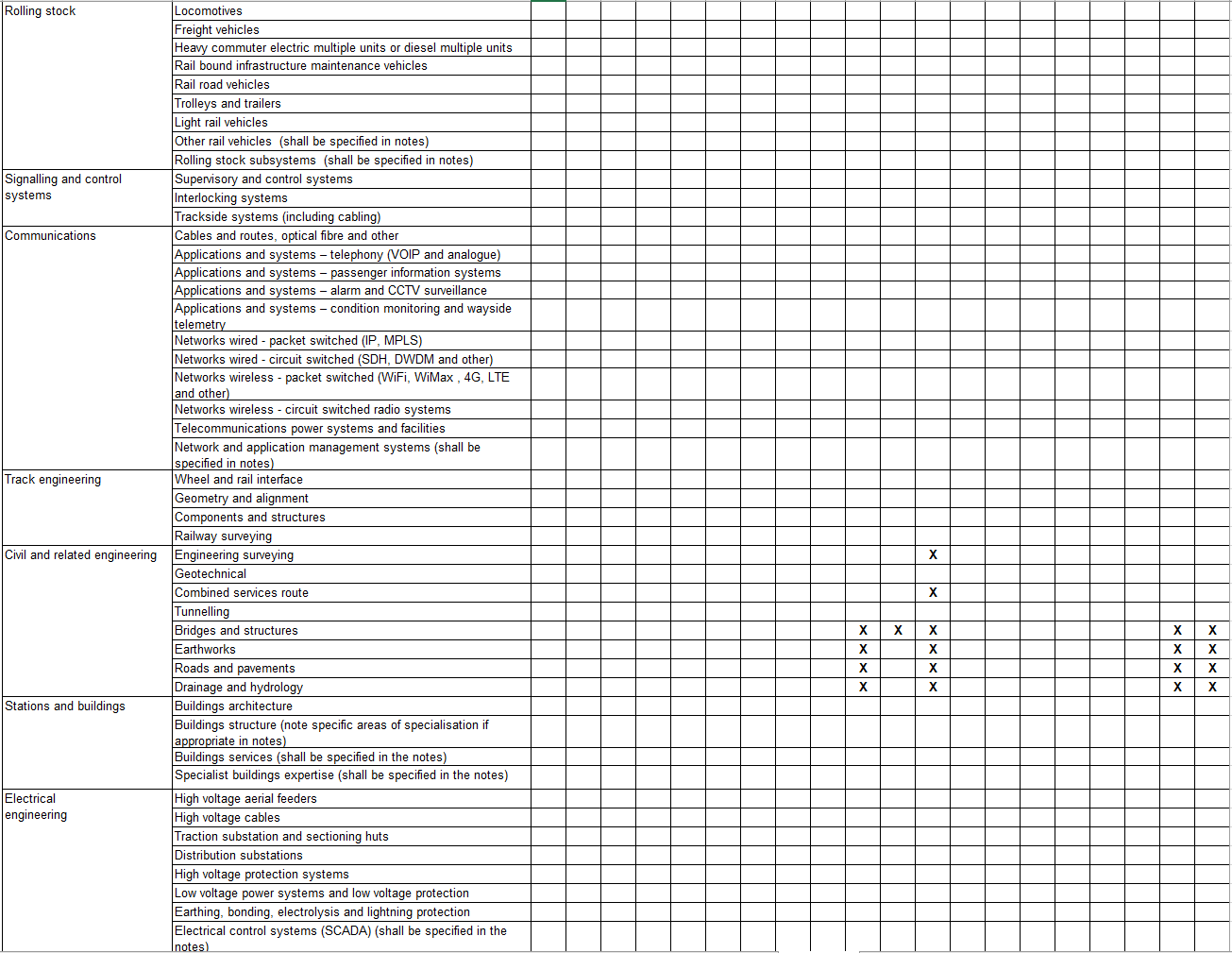
It is crucial to focus on the sub-disciplines that you can demonstrate that you have the capability for in-house with 2 or more projects worth of evidence to reference in the Scope Assessment Form and Self-Assessment Checklist.
2. Split evidence into documented system and deployed system
- Documented system - project plans, organisational policies, processes, procedures and templates which demonstrate the capability to address the requirements
- Deployed system - records of implementation of processes or plans, relevant reports, other records and evidence of actual delivery of engineering services in accordance with documented systems and processes.
Within the Self-Assessment Checklist you should created two sub-headings in the evidence column for each of the criteria as shown below:
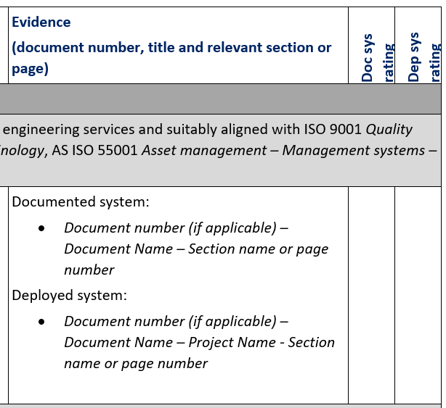
It is recommended that you have a consistent naming convention for documented system and deployed system evidence as shown above.
3. Describe the process in the comments section
We've reviewed a number of applications over the years and we find that the quality of the content entered in the comments section varies company to company as there is a lack of guidance for what should be written. For example, this is a response for RAM Management for a construction contractor that doesn't have design as part of their scope:

4. Have accurate maturity ratings
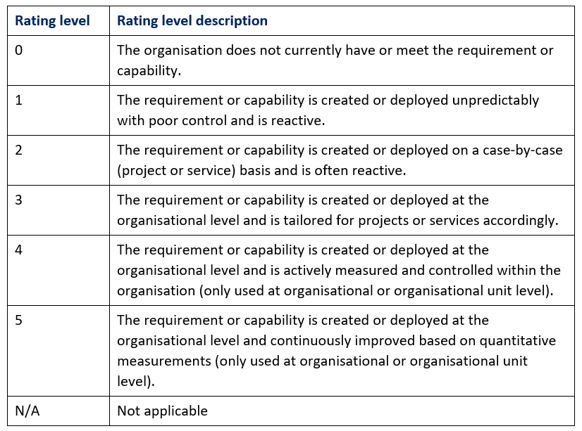
Source: TfNSW t-mu-md-00009-f2 self-assessment checklist
Every documented system and deployed system must have a maturity rating assigned based on the above scale. Make sure you read the scale and rate accordingly, self-assessing a 4 or 5 for most items may make you feel better but if your evidence doesn't back this up you will have the application rejected.
5. Don't rush, address the gaps
Every organisation that we've worked with on AEO applications has gaps with the criteria, generally these are for the system safety assurance and competence management criteria.
Organisations considering AEO have come across this from reviewing tender requirements and may have responded to a tender with the hope of having AEO status by the time it is awarded. Unless the tender is direct to TfNSW there is a chance that you won't have the priority rating to be able to achieve AEO status in time which leads to a rushed application.
Rushing an application will be obvious to the ASA facilitators and TfNSW subject matter experts that review the documentation from the first 2A submission onwards as the description of the processes and referenced evidence in the Scope Assessment Form and Self-Assessment Checklist will be lacking and this will result in your organisation having to wait and then revise your 2A submission adding months to the process.
6. Describe your technical processes in the Scope Assessment Forms
In the Engineering Services Matrix there are 7 disciplines with 49 sub-disciplines. The ASA require that you complete a separate Scope Assessment Form for each sub-discipline that you have selected as being in scope. For example, the following image is of the electrical engineering discipline which has 9 sub-disciplines.
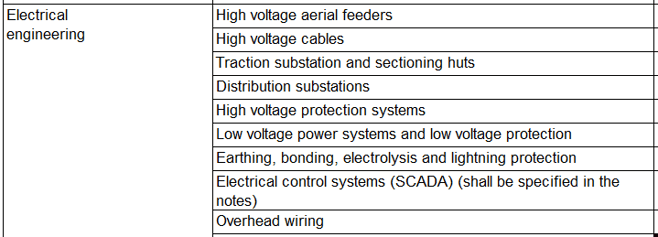
When completing the Scope Assessment Form you should add N/A to the life cycle stages that aren't within the scope of your application. For example in the image below "transport needs analysis, model or plan" through to "concept or reference design" isn't in scope.
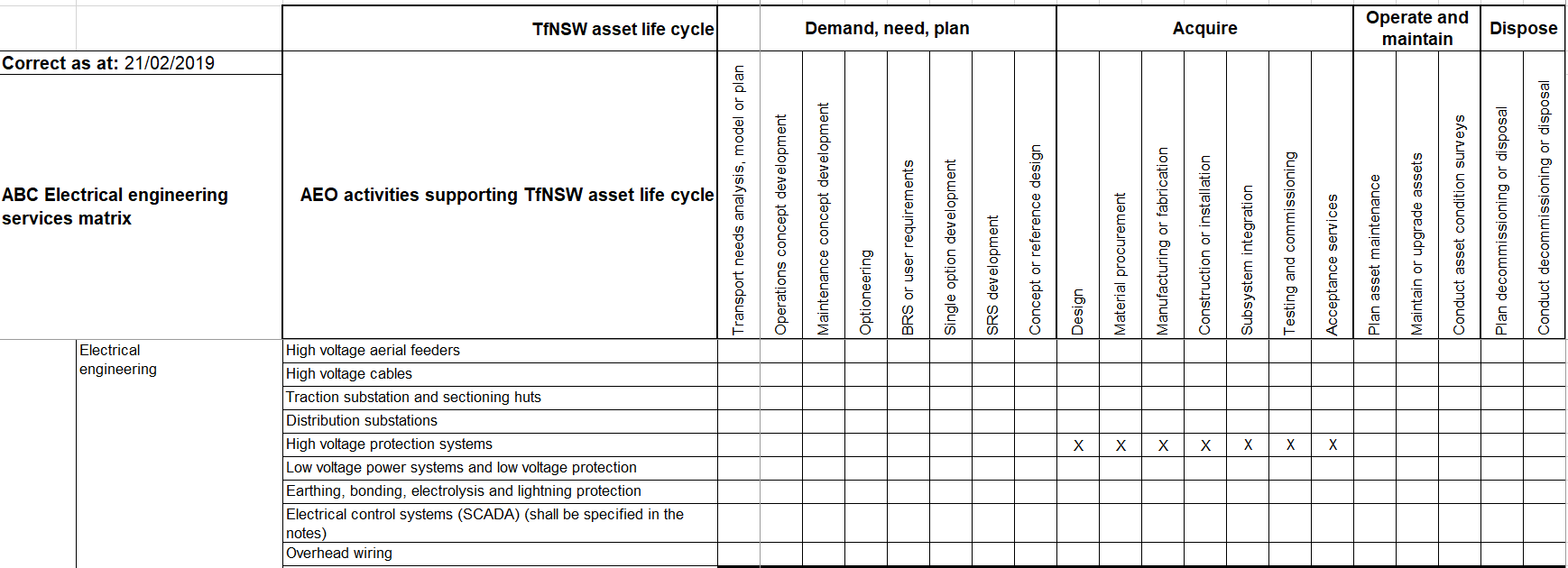
Following the above-mentioned example, one Scope Assessment Form will need to be prepared for the "high voltage protection systems" sub-discipline covering the life cycle stages "design" through to "acceptance services"
7. Describe your technical processes in the Scope Assessment Forms
Using the "high voltage protection system" you would be expected to outline your technical process for each life cycle stage in the Scope Assessment Form and then use dot points to refer to any supporting evidence that is the records of the process you described. This is the same process as referencing deployed system evidence in the Self-Assessment Checklist and you should adopt the same naming convention. An example of what you should describe for the design life cycle stage of this sub-discipline would include:
- Establishment of a Design Management Plan
- Adhering to the TfNSW gates (e.g. 30%, 70% and 100%) and having defined criteria for passing each gate
- Procedure for conducting design reviews, preparing design reports, conducting design validation and verification
- Complected checklists and other records of the above items
- How is the design checking done? By whom? Are there different checklists for different HV protection schemes?
- Reference HV protection designs
- Describe the software that is used to deliver the service and address items such as fault calculations and protection grading.
Conclusion
In conclusion, achieving AEO status isn't an easy endeavour for organisations and you will need to allocate sufficient resources to realistically complete the self-assessment and then work to address the gaps in your organisations process. Its not a matter of thinking you're close enough and you'll get through which may have work for other similar assurance activities like ISO, you will need to demonstrate genuine organisation and project level processes that address the AEO Framework requirements with sufficient evidence of your organisation delivering similar work previously to be successful.
Are you looking to become an AEO? Has your 2A submission been rejected? Reach out to us for an evaluation of your application and personalised advice.


.jpg)
